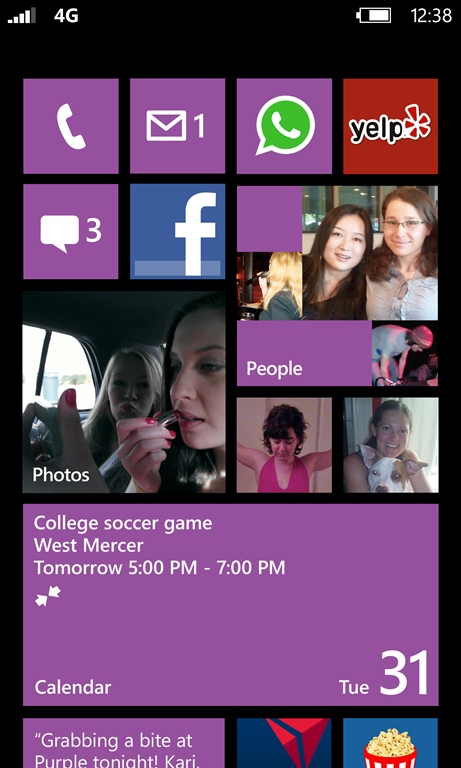Windows Phone 7.8
Microsoft released only limited information on what will be in the Windows Phone 7.8 update, but it is clear that the aim is to deliver some of the new software based experiences found in Windows Phone 8, to existing Windows Phone 7.5 devices, within the limits of the existing hardware specifications.
Microsoft did confirm that Windows Phone 7.8 would include the new style Start screen, which we described in our earlier post on Windows Phone 8:
The new Start screen allows for greater flexibility and customisation, which Microsoft described as "making your device even more personal". The Start screen grid now stretches right across the screen (no more gutter); tiles now come in four sizes: small, medium and large; and additional highlight (theme) colours are available.
Users can switch a tile between any of these sizes to reflect their importance. What's displayed on the tile will depends on its size, with developers able to provide a different implementation for each tile size. New tile experiences will also be available, thanks to improved API support. For example, the Messaging tile, at the large size, will scroll through a list of new messages, where as at medium and small sizes, it will display a count of new messages.
From the Windows Phone blog:
Windows Phone 8 is a generation shift in technology, which means that it will not run on existing hardware. But, we care deeply about our existing customers and want to keep their phones fresh, so we’re providing the new Start screen in this new update.
Microsoft is planning to deliver the Windows Phone 7.8 update "some time after the release of Windows Phone 8".
Comment
There are two ways to look at this. The first, on the negative side, is that Microsoft is not providing an upgrade path for existing smartphones to Windows Phone 8, and if you just bought a Lumia 900 then it's going to be obsolete before the end of the year
The second is a bit more positive. Windows Phone 8 devices will have new tricked out hardware (such as dual-core prcoessors and NFC), and there's no way to replicate this in a software patch - so Windows Phone 7.8 will give your smartphone as much of the software updates as possible, supporting the hardware you bought with the best Windows Phone experience possible.
Not surprisingly, we think the intention is the latter way, but the majority of tech commentators are going to load up the ammo and fire away with the former.
The history of smartphones has seen a number of 'compatibility breaks' where the requirements of new technology simply mean that there is no choice but to move on and support the existing user base as much as possible. Microsoft is looking not just at a compatibility break from Windows Phone 7.5 to accommodate new smartphone hardware, but bringing multiple platforms into the same coding structure (Windows Phone, the recently announced Surface tablet computers, Windows 8 as a whole, and I'm sure the third incarnation of the Xbox - once announced - will be part of the same family). That's a huge undertaking, and while there will be pain, Windows Phone 7.8 is mitigating as much of the pain as possible for existing users, by promising to bring over the latest look and feel to this update, including the new Live Tiles and Start Screen.


But this wouldn't be the first time that new hardware and new software are kept for a new handset, even if there is a geek contingent that shouts (very loudly) that they believe "there is no reason feature X cannot run on the older hardware." (A one word example of that... Siri)
Probably the biggest question will be on the compatibility of Windows Phone 8 apps with Windows Phone 7.8. In short, no. An app coded for Windows Phone 8 will only run on Windows Phone 8, there's is no forwards compatibility.
Note, that you do have backwards compatibility, that's to say Windows Phone 7.5 (and 7.8) apps will run on Windows Phone 8. As a result, I would anticipate that some developers will focus on the lowest common denominator of Window Phones 7.5, at least during the rest of 2012, which will be good news for existing device owners. The situation here feels very similar to Android, where a new version of the OS is announced (e.g. 4.0 and Ice Cream Sandwich), and developers continue to code for older versions (such as v2.3) until there is a critical mass at the new version number.
It's likely the first "non-compatible" applications will be in the gaming space, where the ability to run native code will allow popular middleware and graphical engines to be ported to Windows Phone, allowing for much faster cross-platform development of titles such as Angry Birds.
Perhaps the presentation running up to the Windows Phone Summit on the upgrade path has not been perfect, but I think that Microsoft has delivered a reasonable solution to the upgrade question for existing Windows Phone 7.5 users. The phones will still work tomorrow, they'll have more functionality after the update than before, and when they're ready to update there will be something very shiny for them to pick up in store.
